Range of CD4-Bound Conformations of HIV-1 gp120, as Defined Using Conditional CD4-Induced Antibodies
- PMID: 26889042
- PMCID: PMC4836356
- DOI: 10.1128/JVI.03206-15
Range of CD4-Bound Conformations of HIV-1 gp120, as Defined Using Conditional CD4-Induced Antibodies
Abstract
The HIV envelope binds cellular CD4 and undergoes a range of conformational changes that lead to membrane fusion and delivery of the viral nucleocapsid into the cellular cytoplasm. This binding to CD4 reveals cryptic and highly conserved epitopes, the molecular nature of which is still not fully understood. The atomic structures of CD4 complexed with gp120 core molecules (a form of gp120 in which the V1, V2, and V3 loops and N and C termini have been truncated) have indicated that a hallmark feature of the CD4-bound conformation is the bridging sheet minidomain. Variations in the orientation of the bridging sheet hairpins have been revealed when CD4-liganded gp120 was compared to CD4-unliganded trimeric envelope structures. Hence, there appears to be a number of conformational transitions possible in HIV-1 monomeric gp120 that are affected by CD4 binding. The spectrum of CD4-bound conformations has been interrogated in this study by using a well-characterized panel of conditional, CD4-induced (CD4i) monoclonal antibodies (MAbs) that bind HIV-1 gp120 and its mutations under various conditions. Two distinct CD4i epitopes of the outer domain were studied: the first comprises the bridging sheet, while the second contains elements of the V2 loop. Furthermore, we show that the unliganded extended monomeric core of gp120 (coree) assumes an intermediate CD4i conformation in solution that further undergoes detectable rearrangements upon association with CD4. These discoveries impact both accepted paradigms concerning gp120 structure and the field of HIV immunogen design.
Importance: Elucidation of the conformational transitions that the HIV-1 envelope protein undergoes during the course of entry into CD4(+)cells is fundamental to our understanding of HIV biology. The binding of CD4 triggers a range of gp120 structural rearrangements that could present targets for future drug design and development of preventive vaccines. Here we have systematically interrogated and scrutinized these conformational transitions using a panel of antibody probes that share a specific preference for the CD4i conformations. These have been employed to study a collection of gp120 mutations and truncations. Through these analyses, we propose 4 distinct sequential steps in CD4i transitions of gp120 conformations, each defined by antibody specificities and structural requirements of the HIV envelope monomer. As a result, we not only provide new insights into this dynamic process but also define probes to further investigate HIV infection.
Copyright © 2016, American Society for Microbiology. All Rights Reserved.
Figures


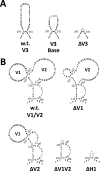

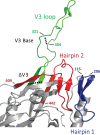
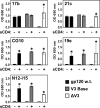


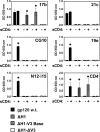

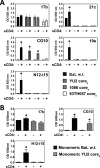
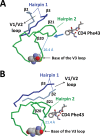
Similar articles
-
Local conformational stability of HIV-1 gp120 in unliganded and CD4-bound states as defined by amide hydrogen/deuterium exchange.J Virol. 2010 Oct;84(19):10311-21. doi: 10.1128/JVI.00688-10. Epub 2010 Jul 21. J Virol. 2010. PMID: 20660185 Free PMC article.
-
Involvement of the V1/V2 variable loop structure in the exposure of human immunodeficiency virus type 1 gp120 epitopes induced by receptor binding.J Virol. 1995 Sep;69(9):5723-33. doi: 10.1128/JVI.69.9.5723-5733.1995. J Virol. 1995. PMID: 7543586 Free PMC article.
-
Unique binding modes for the broad neutralizing activity of single-chain variable fragments (scFv) targeting CD4-induced epitopes.Retrovirology. 2017 Sep 22;14(1):44. doi: 10.1186/s12977-017-0369-y. Retrovirology. 2017. PMID: 28938888 Free PMC article.
-
Structure-based design, synthesis and validation of CD4-mimetic small molecule inhibitors of HIV-1 entry: conversion of a viral entry agonist to an antagonist.Acc Chem Res. 2014 Apr 15;47(4):1228-37. doi: 10.1021/ar4002735. Epub 2014 Feb 6. Acc Chem Res. 2014. PMID: 24502450 Free PMC article. Review.
-
HIV coreceptors: role of structure, posttranslational modifications, and internalization in viral-cell fusion and as targets for entry inhibitors.Biochim Biophys Acta. 2003 Jul 11;1614(1):51-61. doi: 10.1016/s0005-2736(03)00162-7. Biochim Biophys Acta. 2003. PMID: 12873765 Review.
Cited by
-
Probing the Structure of the HIV-1 Envelope Trimer Using Aspartate Scanning Mutagenesis.J Virol. 2020 Oct 14;94(21):e01426-20. doi: 10.1128/JVI.01426-20. Print 2020 Oct 14. J Virol. 2020. PMID: 32817217 Free PMC article.
-
Antibody Recognition of CD4-Induced Open HIV-1 Env Trimers.J Virol. 2022 Dec 21;96(24):e0108222. doi: 10.1128/jvi.01082-22. Epub 2022 Nov 30. J Virol. 2022. PMID: 36448805 Free PMC article.
-
Insights into the molecular mechanism underlying CD4-dependency and neutralization sensitivity of HIV-1: a comparative molecular dynamics study on gp120s from isolates with different phenotypes.RSC Adv. 2018 Apr 17;8(26):14355-14368. doi: 10.1039/c8ra00425k. eCollection 2018 Apr 17. RSC Adv. 2018. PMID: 35540760 Free PMC article.
-
Study on molecular mechanisms of CD4 dependency and independency of HIV-1 gp120.RSC Adv. 2023 Feb 21;13(9):6274-6286. doi: 10.1039/d3ra00433c. eCollection 2023 Feb 14. RSC Adv. 2023. PMID: 36825290 Free PMC article.
-
Elicitation of Cluster A and Co-Receptor Binding Site Antibodies are Required to Eliminate HIV-1 Infected Cells.Microorganisms. 2020 May 11;8(5):710. doi: 10.3390/microorganisms8050710. Microorganisms. 2020. PMID: 32403312 Free PMC article.
References
-
- McDougal JS, Mawle A, Cort SP, Nicholson JK, Cross GD, Scheppler-Campbell JA, Hicks D, Sligh J. 1985. Cellular tropism of the human retrovirus HTLV-III/LAV. I. Role of T cell activation and expression of the T4 antigen. J Immunol 135:3151–3162. - PubMed
Publication types
MeSH terms
Substances
Grants and funding
LinkOut - more resources
Full Text Sources
Other Literature Sources
Research Materials

